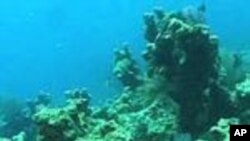<!-- IMAGE -->
The United States and the Republic of Kiribati are teaming up to enhance the management and protection of almost 776,996,000 square kilometers of marine habitat in the Pacific Ocean. The area concerned encompasses 25 percent of all marine protected areas on Earth.
At a signing ceremony on September 23rd, in New York City, New York, the U.S. and the Republic of Kiribati established a "sister site" relationship between the Papahanaumokuakea Marine National Monument, located in the Northwestern Hawaiian Islands, and the Phoenix Islands Protected Area near the equator in the Republic of Kiribati.
Kiribati's President Anote Tong attended the ceremony. Foreign Secretary Tessie Lambourne signed on behalf of Kiribati. Eileen Sobeck, U.S. Department of the Interior deputy assistant secretary signed on behalf of the United States.
The U.S. was also represented by Elizabeth Moore, Director of the National Marine Sanctuaries International Program for the U.S. Department of Commerce's National Oceanic and Atmospheric Administration, and Kurt Campbell, Assistant Secretary for East Asian and Pacific Affairs at the Department of State.
Deputy Assistant Secretary Soebeck said, "In the face of challenges like climate change and increasing societal demands on ever scarcer marine resources -- challenges that transcend national boundaries and dwarf the ability of any single nation to address -- partnerships like this one are critical to the success of our efforts to preserve this natural heritage for future generations."
Director Moore of NOAA noted that the agreement demonstrates the benefits of international cooperation to protect these valuable resources.
When it was established in 2006, the 362,075 square kilometer Papahanaumokuakea Marine National Monument was the largest marine protected area in the world. Its extensive coral reefs are home to over 7,000 marine species, one quarter of which is found only in the Hawaiian
Archipelago.
In 2008, the Phoenix Island Protected Area became the world's largest marine protected area at approximately 410,500 square kilometers. The coral reefs and bird populations there are highly unique and virtually untouched by humans. "By partnering [with the Republic of Kiribati], we hope to collaborate on innovative initiatives highlighting not only the ecological connections we share, but also Pacific heritage and cultural connections we have as island people across Oceania," said Aulani Wilhelm, NOAA's superintendant for Papahanaumokuakea.
Susan White of the U.S. Fish and Wildlife Service noted that the U.S. Kiribati agreement "will help us manage across the ecosystems by comparing and sharing our efforts with each other, as we face many of the same challenges."













